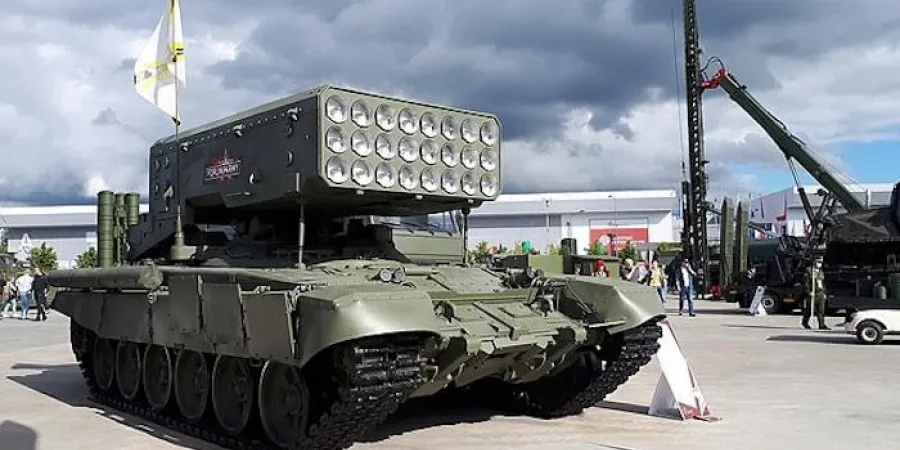Report: Saudi Arabia Interested in Acquiring Russian Rockets with Thermobaric Warheads
From the Russian perspective, the use of thermobaric warheads has been very successful on the battlefield in Ukraine
Cmdr. (res.) Eyal Pinko
| 19/02/2024
From the Russian perspective, the use of thermobaric warheads integrated into rocket ammunition such as the TOS-1A system (the Russian equivalent of the MLRS) manufactured by Omsktransmash, has been highly successful on the battlefield in Ukraine.
The system can launch two projectiles simultaneously. Both projectiles are equipped with thermobaric warheads, which, although not precise, cause significant damage due to the thermobaric effect.
The advanced ammunition, along with the thermobaric warheads, "set Ukraine on fire," according to the Russian description. The thermobaric warheads enable the creation of a massive explosion wave, which leads to high temperatures in the explosion vicinity and intense burning of everything in the surrounding area.
A thermobaric warhead is effective against vehicles, buildings, bunkers, and ammunition depots, and for igniting fires in open areas. The thermobaric warhead creates a destructive effect within a radius of 200 square meters.
During the large arms exhibition held in Riyadh, two upgraded MLRS systems were presented: the TOS-3 Dragon and the TOS-2 Tosochka.
During the exhibition, Alexander Mikheev, CEO of Rosoboronexport (Russia's defense export organization), stated that Russia is in talks to sell these systems to Saudi Arabia. The Russians did not disclose the specifications and details of the new systems.
However, the illustration of the TOS-3 that was circulated on various social media platforms shows that the system includes only 15 rockets (instead of the 24 rockets in the TOS-1A system). It's possible that this is not the actual configuration and is simply a general representation of the system. The TOS-2 ("Tosochka") system was originally developed by NPO Splav for T-72 tanks and was later adapted to the Kamaz platform.
Alongside all the Russian descriptions and recommendations, the prominent drawback of the system was revealed on the battlefield in Ukraine. The range of the ammunition is approximately one kilometer (according to Ukrainian estimates). This drawback creates a situation where Russian artillery batteries are forced to operate close to the enemy, and in order to protect them, they are surrounded by infantry units and armored personnel carriers.
Alongside the rocket batteries, vehicles equipped with drone-jamming systems are also deployed to protect them from aerial attacks during combat. The deployment of these jamming systems is a result of Russian lessons learned from the conflict in Ukraine and the extensive use of Ukrainian drones against Russian targets.
The main advantage of the TOS systems is their ability to carry large thermobaric warheads, which produce significant environmental damage. This compensates for the system's very short range and lack of accuracy.
From the Russian perspective, the use of thermobaric warheads has been very successful on the battlefield in Ukraine
From the Russian perspective, the use of thermobaric warheads integrated into rocket ammunition such as the TOS-1A system (the Russian equivalent of the MLRS) manufactured by Omsktransmash, has been highly successful on the battlefield in Ukraine.
The system can launch two projectiles simultaneously. Both projectiles are equipped with thermobaric warheads, which, although not precise, cause significant damage due to the thermobaric effect.
The advanced ammunition, along with the thermobaric warheads, "set Ukraine on fire," according to the Russian description. The thermobaric warheads enable the creation of a massive explosion wave, which leads to high temperatures in the explosion vicinity and intense burning of everything in the surrounding area.
A thermobaric warhead is effective against vehicles, buildings, bunkers, and ammunition depots, and for igniting fires in open areas. The thermobaric warhead creates a destructive effect within a radius of 200 square meters.
During the large arms exhibition held in Riyadh, two upgraded MLRS systems were presented: the TOS-3 Dragon and the TOS-2 Tosochka.
During the exhibition, Alexander Mikheev, CEO of Rosoboronexport (Russia's defense export organization), stated that Russia is in talks to sell these systems to Saudi Arabia. The Russians did not disclose the specifications and details of the new systems.
However, the illustration of the TOS-3 that was circulated on various social media platforms shows that the system includes only 15 rockets (instead of the 24 rockets in the TOS-1A system). It's possible that this is not the actual configuration and is simply a general representation of the system. The TOS-2 ("Tosochka") system was originally developed by NPO Splav for T-72 tanks and was later adapted to the Kamaz platform.
Alongside all the Russian descriptions and recommendations, the prominent drawback of the system was revealed on the battlefield in Ukraine. The range of the ammunition is approximately one kilometer (according to Ukrainian estimates). This drawback creates a situation where Russian artillery batteries are forced to operate close to the enemy, and in order to protect them, they are surrounded by infantry units and armored personnel carriers.
Alongside the rocket batteries, vehicles equipped with drone-jamming systems are also deployed to protect them from aerial attacks during combat. The deployment of these jamming systems is a result of Russian lessons learned from the conflict in Ukraine and the extensive use of Ukrainian drones against Russian targets.
The main advantage of the TOS systems is their ability to carry large thermobaric warheads, which produce significant environmental damage. This compensates for the system's very short range and lack of accuracy.



